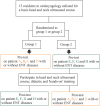Head and neck ultrasound training improves the diagnostic performance of otolaryngology residents
- PMID: 38362178
- PMCID: PMC10866603
- DOI: 10.1002/lio2.1201
Head and neck ultrasound training improves the diagnostic performance of otolaryngology residents
Abstract
Objective: Surgeon-performed head and neck ultrasound (US) is increasingly used among otolaryngologists in office-based and surgical settings. However, it is unknown how formal US training affects otolaryngology residents' diagnostic workup of patients with cervical pathology. This study examined how a formal US course for residents affected their outpatient clinic US performance and diagnostic accuracy.
Methods: We conducted a randomized cross-over trial, where 13 otolaryngology residents participated in a 6-h formal US course. Participants were randomized to perform head and neck US on four patient cases before and after completing the course. Eight patients with and without neck pathology were invited to participate as test cases. The ultrasound examinations were video recorded and anonymized before two consultants rated the US performance using the Objective Structured Assessment of Ultrasound Skills (OSAUS) scale. Otolaryngology residents wrote an ultrasound report with a diagnosis based on their US examination, which was used to calculate the specificity and sensitivity.
Results: We found a statistically significant difference in the OSAUS score before compared to after the hands-on training (p = .035). The diagnostic accuracy also increased from 62% before the course to 75% after the course (p = .02). Specificity increased from 54% prior to the course to 62% following the course, and sensitivity increased from 64% prior to the course to 79% following the course. The intraclass correlation coefficient with "absolute agreement" was 0.63.
Conclusion: This study demonstrates that short, formal ultrasound training can improve otolaryngology residents' ultrasound skills and diagnostic accuracy in an outpatient clinic setting.
Lay summary: This study looks at the change of otolaryngology residents' diagnostic workup of patients after they take a formal ultrasound course and shows that they get better at using ultrasound and make more accurate diagnoses if they take a formal course.
Level of evidence: Level 2.
Keywords: competency‐based assessment; diagnostic accuracy; head and neck ultrasonography; otolaryngology; surgeon‐performed ultrasonography.
© 2023 The Authors. Laryngoscope Investigative Otolaryngology published by Wiley Periodicals LLC on behalf of The Triological Society.
Figures



Similar articles
-
Surgeon-performed ultrasonography.Dan Med J. 2017 Nov;64(11):B5421. Dan Med J. 2017. PMID: 29115210
-
Competency-based assessment in surgeon-performed head and neck ultrasonography: A validity study.Laryngoscope. 2018 Jun;128(6):1346-1352. doi: 10.1002/lary.26841. Epub 2017 Sep 4. Laryngoscope. 2018. PMID: 28868625 Clinical Trial.
-
Advanced head and neck surgical techniques: A survey of US otolaryngology resident perspectives.Auris Nasus Larynx. 2019 Apr;46(2):272-278. doi: 10.1016/j.anl.2018.08.007. Epub 2018 Aug 28. Auris Nasus Larynx. 2019. PMID: 30170906
-
Toolbox of assessment tools of technical skills in otolaryngology-head and neck surgery: A systematic review.Laryngoscope. 2018 Jul;128(7):1571-1575. doi: 10.1002/lary.26943. Epub 2017 Oct 8. Laryngoscope. 2018. PMID: 28988460
Cited by
-
Do dental students need sonography training? A prospective observational study.BMC Med Educ. 2025 Apr 23;25(1):596. doi: 10.1186/s12909-025-07186-8. BMC Med Educ. 2025. PMID: 40269850 Free PMC article.
-
Sustained effects of bladder point-of-care ultrasound simulation exercise on nursing students: A prospective cohort study.BMC Med Educ. 2025 Jan 25;25(1):127. doi: 10.1186/s12909-025-06729-3. BMC Med Educ. 2025. PMID: 39863895 Free PMC article.
-
Human-AI collaboration for ultrasound diagnosis of thyroid nodules: a clinical trial.Eur Arch Otorhinolaryngol. 2025 Jun;282(6):3221-3231. doi: 10.1007/s00405-025-09236-9. Epub 2025 Feb 8. Eur Arch Otorhinolaryngol. 2025. PMID: 39920508 Free PMC article. Clinical Trial.
-
Development and validation of a multiple-choice test for head and neck ultrasound certification.Eur Arch Otorhinolaryngol. 2025 Jul 12. doi: 10.1007/s00405-025-09533-3. Online ahead of print. Eur Arch Otorhinolaryngol. 2025. PMID: 40652140
-
Evaluation of Multiple-Choice Tests in Head and Neck Ultrasound Created by Physicians and Large Language Models.Diagnostics (Basel). 2025 Jul 22;15(15):1848. doi: 10.3390/diagnostics15151848. Diagnostics (Basel). 2025. PMID: 40804813 Free PMC article.
References
-
- Todsen T. Surgeon‐performed ultrasonography. Dan Med J. 2017;64(11):B5421. - PubMed
-
- Untch BR, Adam MA, Scheri RP, et al. Surgeon‐performed ultrasound is superior to 99Tc‐sestamibi scanning to localize parathyroid adenomas in patients with primary hyperparathyroidism: results in 516 patients over 10 years. J Am Coll Surg. 2011;212(4):522‐531. doi:10.1016/j.jamcollsurg.2010.12.038 - DOI - PMC - PubMed
LinkOut - more resources
Full Text Sources
Research Materials
